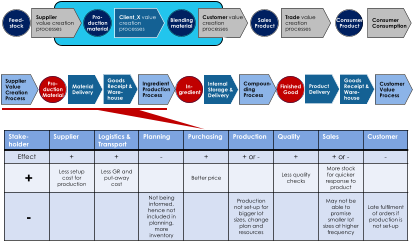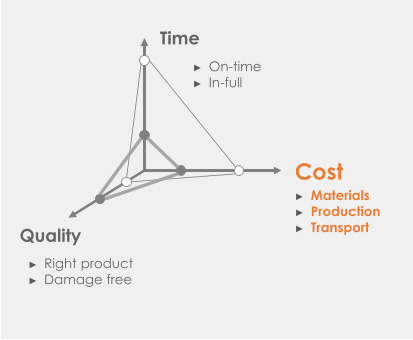

- Value Chain Excellence
- Company Business Performance
- Supply Chain Performance
- Supply Chain Strategy
- Integrated business management (S&OP)
- Digital Transformation
- Operational Improvement
- Transparency
- Complexity
- Agility
- Responsiveness
- Customer Needs
- Delivery Reliability
- SC Segmentation
- Inventory optimization
- Throughput Times
- Order Management
- Planning Excellence
- Cost management
- Logistics Cost
- Working Capital Optimization
- Supplier Optimization
- Transport Optimization
- Network Optimization
- Post Merger Integration
EFFECTIVE COST MANAGEMENT FOR EXCELLENCE IN THE VALUE CHAIN
Besides speed and reliability, cost is a key element in running
effective, high performing supply chains
•
Although being more the traditional elements in
evaluating and designing supply chains and their
performance, they still form the foundation. Cost, quality,
and time are the primary, underlying targets to operate.
Failing in one or more of these three means jeopardizing
the overall business model, not just the supply chain.
•
Cost management builds on transparency. Therefore
having the right cost accounting systems in place is a key
foundation. Traditional cost allocation mechanisms need
to be replaced by “activity based costing” approaches to
monitor process cost, but also factor cost for the individual
operations. For an example, see the logistics cost section.
•
Factor cost reductions are a traditional way to reduce
cost. Just pay less, and expect to get the same result - this
works sometimes, but in most cases this leads to new
challenges. Therefore cost / price driven initiatives need to
be monitored carefully, and should be based on a more
integrative, sustainability driven approach.
•
Important consideration in this context is to look at the
total cost along the chain, which is covered by “Total Cost
of Ownership” approaches. Similar to the underlying
principles of activity based costing, this method looks for
the impact of cost reductions in one area, on the cost
position in all other areas in the supply chain, thus creating
an integrative perspective. Typical example here are
purchase price reductions which result in quality issues,
availability issues, supply flexibility problems, or other
shortfalls like problems in production to use a cheaper
ingredioent or packaging material
•
As a core foundation, IN-NOVA appraoches regarding
supply chain cost look for opportunities to avoid cost. This is
why we use the methods of LEAN to identfy which
activities in the supply chain are driven by waste, or by
efforts to avoid and dispose of waste. Waste can be
rework, additional activities, yield related problems, excess
driving distances, obsolescence from wrong/outdated
stock items, or many other reasons.
•
And there are many more aspects to consider in
optimizing supply chain cost… and most of them need to
be configured and selected according to the specific
situation and needs of your company. Please contact us if
you are interested in more details.

















